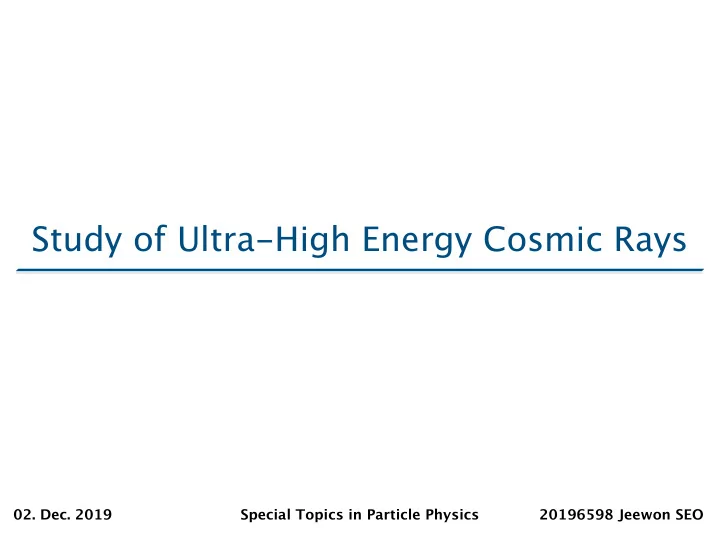

Study of Ultra-High Energy Cosmic Rays 02. Dec. 2019 Special Topics in Particle Physics 20196598 Jeewon SEO
Outline • Introduction • Cosmic Rays and UHECR • GZK Cut-O fg • Detection • Air shower • Experiments and method • Conclusion 22. Nov. 2019 Particle Astrophysics Lecture 2
Introduction • The first observation of a cosmic ray particle with an Ultra high energy was made by Volcano Ranch experiment in New Mexico. • The existence of such energetic particles remains a mystery. • How are UHECR accelerated to the extreme energies? • Where they come from? • What is composition of them? 22. Nov. 2019 Particle Astrophysics Lecture 3
Cosmic Rays • High energy proton and atomic nuclei which rain down on the Earth from outside of the solar system. • Energy range : 10 9 eV ∼ 10 20 eV • The flux of these particles decreases as their energy increases. 22. Nov. 2019 Particle Astrophysics Lecture 4
Ultra High Energy Cosmic Ray • UHE > 10 18 eV • Would not be trapped in Ultra High Energy Extra galactic origin the magnetic fields of a spiral galaxy. • The origin of these particles is expected to be extra galactic. • GZK limit and cut-o fg 22. Nov. 2019 Particle Astrophysics Lecture 5
GZK cut-o fg • Greisen-Zatsepin-Kuzmin limit E th = 5 × 10 19 eV • The upper limit on the energy of cosmic ray protons traveling from other galaxies through the intergalactic medium to our galaxy. • Derived under the assumption that UHE cosmic rays are protons. • The protons of coming E > E th from beyond the local galactic would have their energies attenuated by collisions with the CMB photon. • The flux above about 5 × 10 19 eV should fall o fg sharply 22. Nov. 2019 Particle Astrophysics Lecture 6
Detection • The method of cosmic ray detection depends on the energy of the particles. • Direct Measurement Indirect Measurement • E < E 15 eV • Balloon, satellite and space shuttle. Direct Measurement • Indirect measurement • E > E 16 eV • Measured by the showers generated in the atmosphere. 22. Nov. 2019 Particle Astrophysics Lecture 7
Air Shower • When cosmic rays enter the Earth’s atmosphere they collide with atoms and molecules, mainly oxygen and nitrogen. • The interaction produces a cascade of lighter particles, so-called air shower. • Extensive Air Shower (EAS) • If the primary particle is a high energy proton or heavier nucleus, cascade can develop through the atmosphere. • Widely spread 22. Nov. 2019 Particle Astrophysics Lecture 8
Indirect detection experiment • Ground Array Experiments • Consist of particle detectors that are spaced at di fg erent distances from each other. • Typically composed of scintillation counters or water Cherenkov tanks. • Determine the arrival direction of an EAS • Atmospheric Light Emission Experiments • Two type of emitted light: Cherenkov light and nitrogen scintillation • The Cherenkov light is highly collimated with respect to the original particle direction. -> useful for lower energy events and particularly in searching for point sources. • Nitrogen molecules are excited by the EAS and can radiate their energy by producing near-ultraviolet photons. The emitted light is isotropic. -> allows a large collection area which makes it useful for UHECR. • Some experiments are combined the di fg erent technique. 22. Nov. 2019 Particle Astrophysics Lecture 9
Pierre Auger Observatory Ultra high energy cosmic ray Extensive air shower Fluorescence detectors Water Cherenkov Detector 22. Nov. 2019 Particle Astrophysics Lecture 10
Cherenkov Detector 22. Nov. 2019 Particle Astrophysics Lecture 11
Telescope Array Project 22. Nov. 2019 Particle Astrophysics Lecture 12
Fluorescent detector 22. Nov. 2019 Particle Astrophysics Lecture 13
Scintillation Counter 22. Nov. 2019 Particle Astrophysics Lecture 14
Conclusion • The source for very energetic particles is still unknown. • Several projects are looking for possible source of UHECR to provide a better understanding of the nature of the universe. 22. Nov. 2019 Particle Astrophysics Lecture 15
Recommend
More recommend